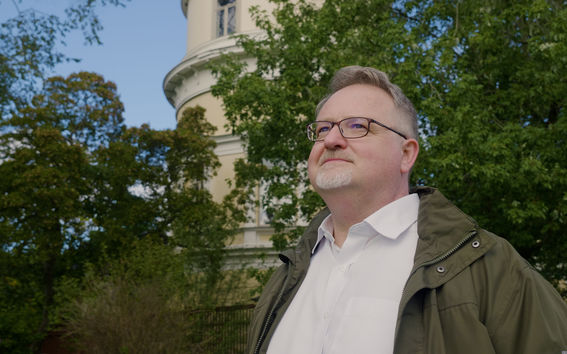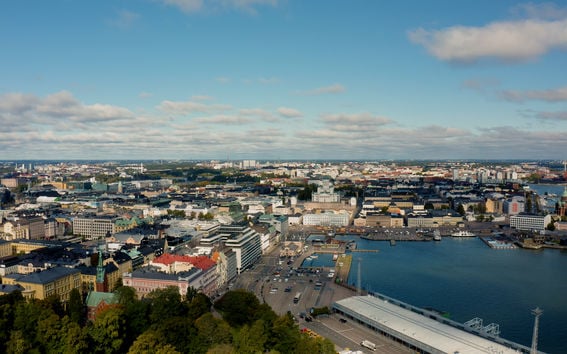Toni Kotnik: Thinking in Structures

The German-born professor has developed a cross-disciplinary approach to the built environment to respond to the growing need for sustainability.
‘My research explores how order emerges in material systems and how these organizational principles can unfold design potential. I expand the ideas of functional morphology from biology into cultural realms and explore architecture as an expanded natural environment’, he puts it in brief.
For Toni Kotnik architecture is not only about providing space for human activities but at the same time about creating a local environment for example by providing shading, improved ventilation, or the control of thermal conditions.
However, all these functions should not be achieved by adding machines and using more energy but rather by intelligent use of materials like for example in a stem of a tree. Stems consist of cells that can vary in size and thickness of the cell wall.
Variation of these properties allows for the development of properties like stability or the ability to transfer fluids or the storage of nutrition. Toni Kotnik explores such interaction of elements within a large system, with the goal to reform the traditional way of designing the built environment.
Shaping the built environment for more sustainable living
Professor Kotnik embarked on this path early on as a young math graduate, before his first PhD from Zurich. He was nominated for a scholarship by a foundation for academic and artistic talents, dedicated to providing young students with intellectual stimulation.
‘It was one of those summer schools where I had discussions with a professor of theology and archaeology who invited me to work at an excavation site in Palestine. It fitted perfectly in my life at that time’, he recalls.
Working at the excavation site constantly made him question when a stone is a stone and when a stone is a part of a wall. This created a connection between his studies of math and the geometry of relations.
’The question why this structure is there appeared in the excavation site. I realised architecture was a way to continue in this direction. This made me study architecture as a second degree and has been driving my research interest since then.’
Eventually, computational science crystallised his ideas. It was about shaping the built environment, to drive more sustainable architecture in the bigger picture.
Professor Toni Kotnik, Aalto UniversitySustainability is a must, and the complexity of the issues means we need creativity and a diverse set of disciplines to solve the problems."
Creativity and a diverse set of disciplines needed to solve complex problems
How did the academic environment respond to these cross-disciplinary ideas?
‘This is still not mainstream, though the reservations used to be greater twenty years ago’, Kotnik smiles knowing he still may be pushing the comfort zone of his colleagues.
According to Toni Kotnik, to enable multidisciplinary discussion you need to know basic terminologies and concepts, which allow us to open up the discussion. However, you don’t need to have deep expertise in all the disciplines to be able to synthesize engineering and environmental thinking as well as computational science to recognise certain patterns and relationships.
Today, Kotnik has partners in research from Europe, Asia, and the US. After six years in Aalto, he is surrounded by a growing community of graduates who are taking these ideas into Finnish practise.
The megatrends like sustainability and digitalisation as a new lingua franca have developed to support his ideas not only in Aalto but also internationally.
‘It’s now obvious that sustainability is a must, and the complexity of these issues means we need more creativity and a diverse set of disciplines to solve the problems. I see this paradigmatic change as a lifetime project’, he concludes.
Academic positions with an open agenda are rare
Toni Kotnik has always been open to look for opportunities globally. He has moved so many times he cannot even tell. He also likes to travel a lot for pleasure, hiking in the mountains as well as strolling through big cities with vivid culture.
After working and living in locations like Zurich, Singapore, and London, what made him settle in Aalto University, Helsinki, Finland more than six years ago? He reveals several reasons.
‘Obviously, academic environments are essential criteria for such decisions. Once you get to the post doc level you don’t easily find a position fit for developing your ideas. It is very rare to find these positions with such an open agenda of the entire university’, he says, and adds that it is also nice to find an environment that attracts you and where you can find work-life balance.
Germany, his native country, Toni Kotnik left 25 years ago and has made his whole career abroad. He says he finds it enriching being a foreigner, noticing the different aspects of life in new places.
‘You can experience some familiarity but also strangeness. You start to value the diversity and cultural differences. I now have much more understanding of my European background, and I feel much more European than German’, he admits.

Relaxed living in the Helsinki Design District
Kotnik has several reasons for working at Aalto University. One of them is the fact that as a young university it is still developing, which allows it to shape the way it works.
‘As I come from architecture, the multidisciplinary agenda of Aalto University means important flexibility for me, combining the artistic and technical dimensions’, he says.
He also has an eye for Scandinavian architecture, where buildings and nature are typically emerging together. Helsinki was already familiar to him. In addition to architecture, he had noticed the appreciation of design when walking around and exploring the city.
‘I found it attractive. My living area, Ullanlinna in Helsinki is part of the Design District, which is interesting’, he points out.
Toni Kotnik looks at Finland as a mix of natural and built environment. He finds the pace of life relaxed and thinks the way of living is calm compared to some big cities in other parts of the world.
‘On a personal level, I also like the Moomins. I used to read some of the comics when I was young, and I was fascinated by these figures. However, I did not realise then that they came from Finland.’
Kotnik shares his personal life with two cities. His wife is also an academic, professor for Marine Natural Products Chemistry in Kiel, Germany.
‘We keep on commuting all the time between Kiel, Germany, and Helsinki, Finland. The cultural exchange has always been vivid in this area, ever since the Vikings. Life in this region is influenced by the sea. We regard the Baltic region as our final destination.’
Toni Kotnik in brief
- Toni Kotnik (born 1969, Germany) is Professor of Design of Structures at Aalto University in Helsinki, Finland. He studied architecture, mathematics and computational design in Germany, Switzerland and the US, and received his doctoral degree from the University of Zurich.
- Before joining Aalto, he taught at several institutions, including the ETH in Zurich, the Architectural Association in London, the Institute for Experimental Architecture at the University of Innsbruck and the Singapore University of Technology and Design.
- His practice and research work has been published and exhibited internationally, e.g. in the Venice Biennale, and is cantered on the integration of knowledge from science and engineering into architectural thinking and the design process.
Text: Aino Soutsalmi / Medita
Photos and video: Mika Vartiainen / Aalto Studios
- Published:
- Updated:
Read more news

This is how smart textiles can look like: self-cleaning cotton or a colour-changing print
An article by YLE Svenska about 'Beyond e-Textiles' project and 'Interlaced' exhibition at the University of Turku
Ammonia – a new green energy solution? Research project receives €2.5 million in funding
Ammonia is a promising alternative fuel for the marine industry and for storing green hydrogen, but there are many question marks over its use.
A new project in Espoo aims to improve disparities in children's learning outcomes – with the goal of preventing social segregation
Supporting children's learning skills has a major impact on their further education and employment, among other things.